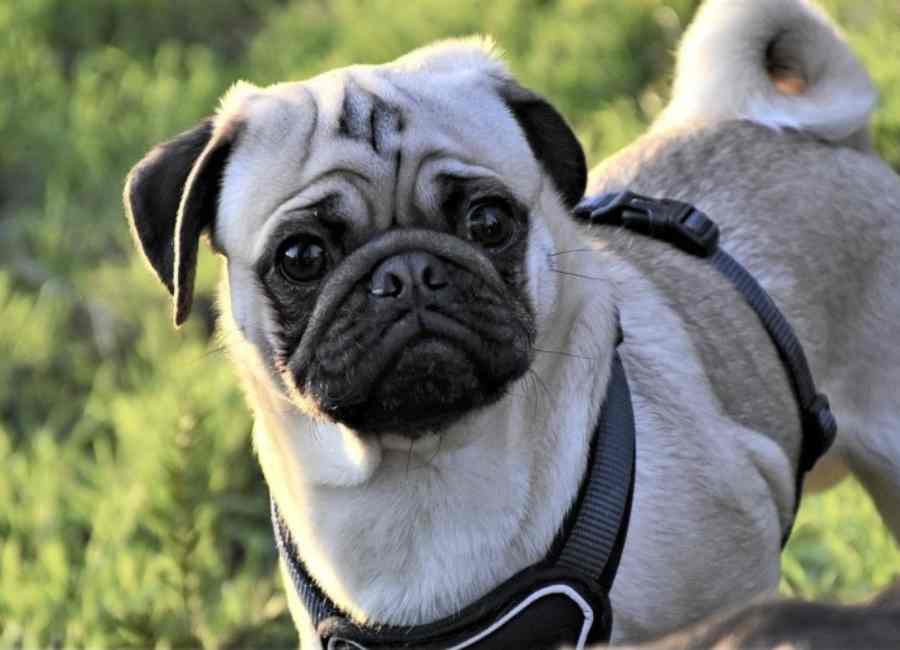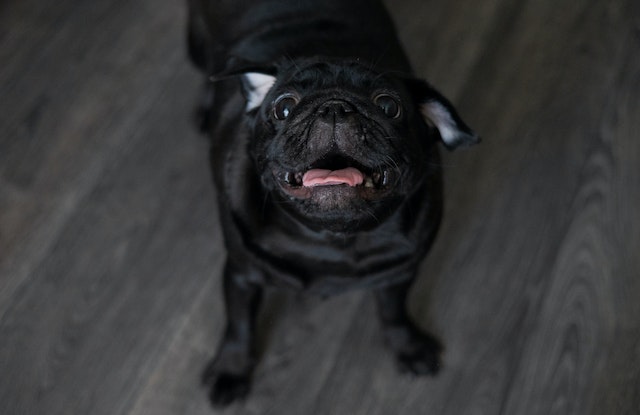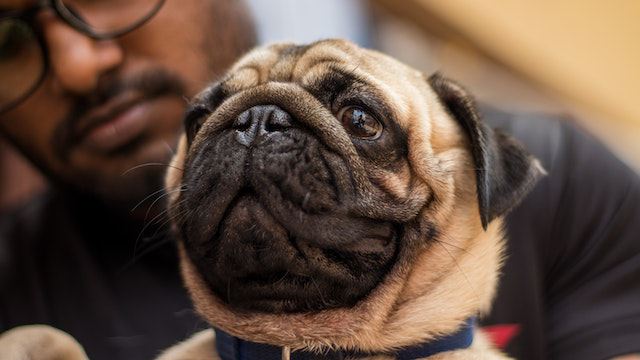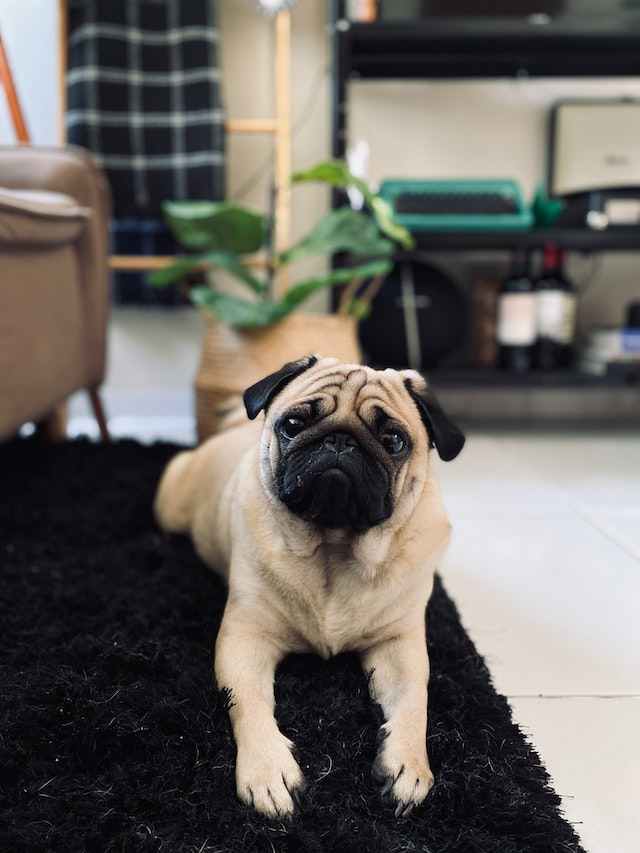9 Pug Growling Reasons & How to Address It

While it might seem intimidating at first, a Pug growling can actually be a sign of affection or playfulness.
In today’s post, we’ll explore this quirky behavior and what it really means when your beloved Pug lets out a growl.
So, buckle up and get ready to learn everything you need to know about Pug growling!
Why do Pugs Growl?
Pugs are known to growl when they feel threatened or anxious, as growling is also a way for them to communicate and express their discomfort or displeasure.
To prevent growling, it’s important to understand and address the underlying cause of their behavior.
Let’s break it down further for better understanding…
Reasons for Pug Growling

The following are some common reasons for pug growling:
1. Resource Guarding
Growling may occur when a Pug perceives a threat to their possessions, such as food, toys, or even their favorite spot on the couch.
To tackle resource guarding, establish a consistent routine for feeding and playtime, and gradually introduce positive reinforcement training to teach your Pug that sharing is rewarding.
Avoid forcefully taking away their belongings, as it may escalate the issue. Instead, encourage a “trading” system by offering a desirable treat or toy in exchange.
2. Fear or Anxiety
Fear or anxiety in pugs can be one reason for growling. It is important to identify the source of the fear or anxiety, and then gradually expose the pug to it in a positive and controlled manner.
This can involve desensitization training, which involves introducing the pug to the source of fear or anxiety in small increments until they are comfortable.
Additionally, providing a safe and comfortable environment for the pug can help reduce their anxiety. Always approach a fearful or anxious pug with caution and patience to prevent further incidents of growling.
3. Pain or Discomfort
When Pugs are in pain or discomfort, they may resort to growling as a means of communication. It could be due to a variety of factors, including health issues, such as arthritis, dental problems, or injury.
Regular veterinary check-ups are essential to identify and address any underlying medical conditions. Follow the prescribed treatment plan, and provide a comfortable and supportive environment to alleviate your Pug’s pain, thus reducing the likelihood of growling.
4. Lack of Socialization
During a Pug’s crucial developmental stage, a lack of exposure to various people, animals, and environments can result in fear-based behaviors like growling. By gradually exposing your Pug to new experiences, you can encourage social interaction.
To help your dog gain confidence, sign up for obedience classes or plan playdates with other polite dogs. Growling brought on by socialization problems can be significantly reduced with persistence and ongoing positive reinforcement.
5. Overstimulation
Pugs are renowned for their playful and vivacious personalities, but too much excitement can cause growling. Growling may be a way for animals to communicate their need for a break when they are feeling overstimulated, or overwhelmed, or when they are playing vigorously.
Keep a close eye on your Pug’s behavior and give him or her regular rest and relaxation opportunities. To help them escape when they feel overwhelmed, designate a quiet area.
6. Lack of Training and Boundaries
Pugs are a breed of dog, and all dog breeds require proper training. When a Pug lacks clear boundaries or has not been taught appropriate behavior, growling may happen. Training techniques that emphasize consistency and positive reinforcement can help set limits and reinforce desired behaviors.
Spend time in practice sessions, concentrating on the verbal instructions “sit,” “stay,” and “leave it.” Remind yourself to give treats, compliments, and love as rewards for good behavior.
7. Environmental Triggers

Pugs may start growling in response to a variety of environmental stimuli, including loud noises, strange surroundings, or sudden movements.
Determine potential triggers, and gradually acclimate your Pug to them with controlled exposure and reinforcement. Make sure your Pug has a place to go to when they feel overwhelmed, like a crate or a designated quiet area.
8. Territorial Behavior
Pugs, despite their small size, have a tendency to act aggressively in defense of their perceived territory, such as their home or favorite spot, by growling. Establish boundaries and rules up front to stop territorial growling.
Introduce visitors or other animals gradually, while giving clear instructions and rewarding restrained behavior. Additional advice that is specifically suited to your Pug’s needs can be obtained by speaking with a qualified dog trainer or behaviorist.
9. Frustration
Pugs may growl out of frustration when they are unable to adequately express their needs or desires. Observe your pug’s body language to determine where their annoyance is coming from.
Make sure to provide for their basic needs, including food, water, exercise, and mental stimulation. Play interactively with them and give them puzzle toys to keep their minds active. You can lessen their growling by addressing their annoyance.
Learn more about pug behavior problems.
Recognizing Pug Growling Signals
Apart from the vocalization of growling, pugs communicate their emotions through their body language. Some common cues to watch out for include raised hackles, tense body posture, a stiff tail, and direct eye contact. Recognizing these signals can help you understand your pug’s emotional state.
Growling can have variations in pitch, intensity, and duration, which may convey different meanings. Low and continuous growling may indicate aggression or a more serious threat, while higher-pitched growls can signal fear or discomfort. Listening to specific sounds can provide insights into your pug’s intentions.
Learn more about why your pug is barking.
Tips for Addressing Pug Growling

Pugs are adorable dogs, but sometimes they can be quite vocal. Growling is one of the ways they communicate, but excessive growling can be a problem.
Here are some training tips for addressing pug growling.
1. Socialize your pug
Socializing your pug is critical to ensure they know how to behave in different situations and around different people. Proper socialization can help minimize growling.
2. Reward good behavior
Rewarding good behavior is an effective training method to encourage your pug to behave appropriately. Use treats and positive reinforcement to promote good behavior.
3. Don’t punish growling
Punishing your pug for growling can actually make the problem worse. Your pug may start to hide their growling instead of warning you of their discomfort.
4. Identify the cause of growling
Try to identify the cause of your pug’s growling. It could be due to fear, anxiety, aggression, or other reasons. Once you know the cause, you can come up with a training plan to address it.
5. Teach your pug to be calm
Teach your pug to be calm and relaxed in different situations. You can do this through regular training exercises such as sit, stay, and down.
6. Provide plenty of exercise
Pugs need regular exercise to help them burn energy and stay healthy. A tired pug is less likely to growl excessively.
7. Train with a professional
Consider working with a professional dog trainer to help you train your pug and address their growling behavior. A trainer can provide helpful tips and advice tailored to your specific needs.
8. Distract your pug
When your pug starts to growl, try to distract them with a toy or treat. Give them something else to focus on instead of the thing that’s causing them to growl.
9. Be patient and consistent
Training your pug takes time and patience. Consistency is key to helping them learn new behaviors and reduce their growling. Stick with the training plan and be patient with your pug as they learn.
Learn more about ways to discipline your pug.
Related Questions
Can pugs growl out of happiness?
While growling is commonly associated with negative emotions, some pugs may exhibit a soft growling sound when they are happy or content. It is essential to observe their body language and overall behavior to differentiate between happy growling and growling caused by fear or discomfort.
Should I punish my pug for growling?
No, punishment is not recommended when dealing with growling behavior. Punishment can escalate the problem and potentially lead to more aggressive behavior. It is crucial to address the underlying causes and employ positive reinforcement-based training methods.
Can growling be completely eliminated from a pug’s behavior?
While it may be challenging to completely eliminate growling from a pug’s behavior, it can be effectively managed. By understanding the triggers, providing appropriate training, and creating a safe environment, you can reduce the frequency and intensity of growling episodes.
Can pug growling indicate a medical issue?
Yes, growling can sometimes be a sign of pain or discomfort caused by an underlying medical condition. If you notice any changes in your pug’s behavior, including increased or sudden growling, it is advisable to consult a veterinarian to rule out any potential health issues.
How long does it take to address pug growling through training?
The time it takes to address pug growling through training can vary depending on various factors, including the severity of the behavior and consistency in training efforts. With patience, persistence, and the right techniques, you can expect to see positive changes over time.
Learn more about pug temperament.
Conclusion
Pug growling can be a concerning behavior, but with understanding and proper techniques, it can be addressed.
By identifying the reasons behind the growling, recognizing their signals, and implementing positive training methods, you can help your pug overcome their anxieties and communicate their needs more effectively.
Remember to seek professional guidance when needed and provide a loving and supportive environment for your pug’s well-being.
